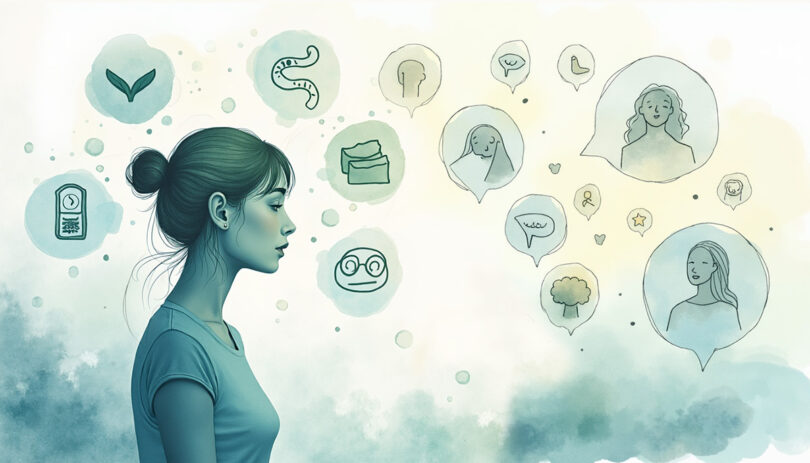There’s a moment I remember clearly: sitting on my bedroom floor at 3 AM, heart racing, mind spinning through an endless catalog of worst-case scenarios. My rent was due, my relationship was strained, and a work deadline loomed ominously. The worry felt like a physical weight—a tightness in my chest that made each breath shallow and unsatisfying.
This post contains Amazon affiliate links, meaning I may earn a small commission if you purchase through my links, at no extra cost to you. Note: We aim to provide accurate product links, but some may occasionally expire or become unavailable. If this happens, please search directly on Amazon for the product or a suitable alternative.
That night marked both a low point and a turning point in my relationship with worry. Today, I want to share what I’ve learned about transforming worry from a controlling force into a gentle messenger—because if I could make that journey, I believe you can too.
Understanding Worry’s True Nature
Worry isn’t the enemy we often make it out to be. It’s simply one color in the rich emotional palette we’ve been gifted as humans. Our emotions—all of them—serve as an internal navigation system, highlighting when something needs our attention.
Think about it: when your phone battery gets low, it sends you a notification. That alert isn’t a problem; it’s information. Similarly, worry is your inner wisdom sending you a notification that something needs addressing.
The trouble begins when we treat these notifications as emergencies requiring immediate and constant attention. We forget that we have the power to acknowledge the message and then decide how to respond.
(If you struggle with anxiety, a guided journal for stress relief can help you process emotions constructively.)
The Heart-Mind Connection
For years, I approached worry exclusively through my mind. I’d analyze, rationalize, and think my way around problems—sometimes productively, but often just spinning in exhausting mental circles. What I didn’t realize was that I was only engaging half of my internal wisdom system.
Our minds are remarkable tools—they store information, process data, and help us navigate logistics. But they’re not designed to be the sole directors of our lives. That’s where the heart comes in.
It’s fascinating to consider that our hearts sit at the literal center of our physical bodies—the balance point between left and right. This isn’t just poetic; research in neurocardiology shows that our hearts contain their own complex nervous system, sometimes called a “heart brain”, that communicates bidirectionally with our cranial brain.
When we operate primarily from our analytical minds, we create the same imbalance we see reflected in our wider world—too much doing, not enough being; too much consumption, not enough creation; too much fear, not enough trust.
Finding Your Center Again
So how do we restore balance when worry has tipped us off-center? Here’s what worked for me:
- Make your mind your ally, not your master
I began by noticing when my thoughts were running the show. Sometimes I’d literally say aloud, “Thank you for trying to protect me, but I’m choosing a different perspective now.” This simple acknowledgment helped me step back from being completely identified with my thoughts.(A great tool for this is the book “The Power of Now”, which teaches mindfulness techniques.) - Reprogram with intention
Our minds are constantly being programmed—by media, by others’ opinions, by our own repetitive thoughts. I started taking an active role in this programming by consciously choosing what I exposed myself to. I created morning rituals that included reading uplifting material, listening to inspiring talks, and writing down thoughts that expanded rather than contracted my sense of possibility.(Try a gratitude journal to shift your mindset daily.) - Examine your beliefs about worry itself
One of my most limiting beliefs was that worrying was responsible and necessary—that if I stopped worrying, bad things would happen because I wasn’t being vigilant enough. When I examined this belief closely, I realized it wasn’t serving me. Worrying hadn’t prevented difficulties; it had only prevented me from being fully present to address them effectively. - Transform worry into wonder
When worry arises now, I try to meet it with curiosity rather than resistance. “What’s this feeling trying to tell me? What action, if any, would be helpful right now?” Sometimes the answer is concrete action. Other times, it’s simply to breathe, trust, and allow life to unfold.(Meditation apps like Headspace can guide you through this process.)
The Energy Exchange
Consider this: worrying and taking constructive action both require energy. The difference is that worry depletes us while leaving the situation unchanged, whereas action moves us forward and often energizes us further.
I remember fretting for weeks about a difficult conversation I needed to have with a friend. The amount of mental energy I spent rehearsing worst-case scenarios could have powered a small city! When I finally had the conversation, it took fifteen minutes and went better than I could have imagined. The lesson was clear: the energy I’d spent worrying could have been directed toward something that actually enhanced my life.
(Need help with difficult conversations? Check out Crucial Conversations.)
Final Thought: You Are Not Your Worries
If you’re currently in the grip of worry, I want to offer you this gentle truth: this moment, exactly as it is, contains everything you need. Your worry is not a failure or a weakness—it’s simply information asking for your compassionate attention.
Take a deep breath. Feel your feet on the ground. Place a hand on your heart. Remember that you are more than your worries, more than your thoughts, more than any temporary circumstance.
The path from worry to peace isn’t about eliminating challenges from your life—it’s about relating to them differently. It’s about remembering that between stimulus and response lies your greatest power: the freedom to choose.
And in that choosing, you might just discover that the world is wider, more supportive, and more filled with possibility than your worries ever allowed you to see.
(For more tools on emotional resilience, explore The Anxiety Toolkit.)
Affiliate Disclosure. This post contains affiliate links. If you make a purchase through these links, I may earn a small commission at no extra cost to you. Thank you for supporting my work!







